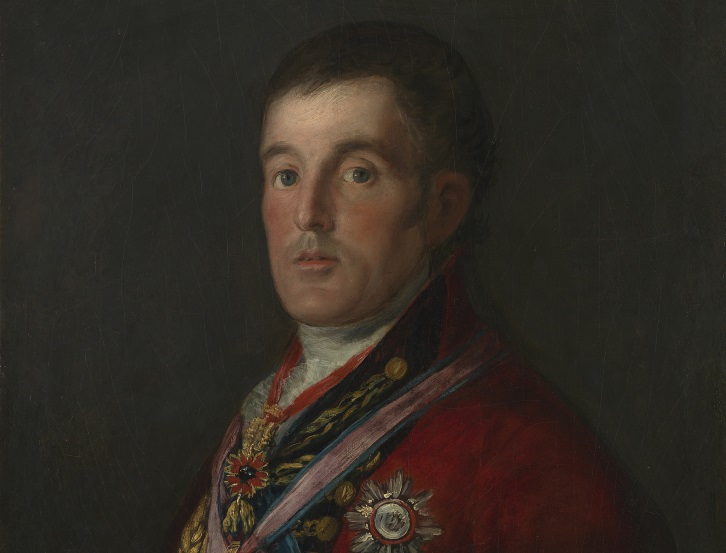The National Gallery: the missing masterpiece

Francisco de Goya, The Duke of Wellington © The National Gallery, London. Bought with aid from the Wolfson Foundation and a special Exchequer grant, 1961
On 21 August 1961, the National Gallery suffered its first art theft in 137 years. Overnight, and just 19 days after it was installed, a key portrait of Arthur Wellesley (1769-1852) the Duke of Wellington, vanished.
That the picture was on display at all was due to the Wolfson Foundation. In May 1961, Sir John Witt (1907-1982), the Gallery’s Chairman of Trustees, alerted the Foundation that ‘A highly critical situation has…now arisen concerning a picture which is an essential part of British history.’ At the height of the Peninsular War the Spanish painter Francisco de Goya (1746-1828) captured in oils the victorious Wellington after his entry into Madrid. The painting had been sold at Sothebys (to an American buyer) for £140,000.
Wolfson responded rapidly to save the work for the nation. If the British Government would pledge £40,000 (which the Prime Minster, Harold Macmillan did) then the Foundation would remit the huge sum of £100,000. The gift was acknowledged in Parliament and by John Witt, who characterised it as ‘majestic’.
Then came the theft. Despite a wry aside for the purchase of ‘a share in a blank wall’, the Wolfson Foundation honoured its six-figure commitment. Meanwhile, a small media circus built up around the identity of the thief and a series of anonymous letters about the stolen painting. These were followed by the Duke’s guest appearance in Terence Young’s 1962 James Bond movie Dr.No, adorning the secret headquarters of Joseph Wiseman’s master criminal.
By 1965, the picture was found, abandoned in a left luggage office in Birmingham, the claim ticket posted to The Daily Mirror. The thief (alas, not Dr No) handed himself in to the police. Today, Goya’s picture (NG63322) can still be enjoyed in Room 38 of London’s National Gallery.
Explore the archives
- WF/72/3
Letter from John Witt, National Gallery, London, 11 May 1961, to Isaac Wolfson - WF/72/13a, b
Letter from John Witt, National Gallery, London, 21 June 1961, to Sir Harold Redman, The Wolfson Foundation - WF/72/18a, b
Copy letter from Sir Harold Redman, The Wolfson Foundation, 18 July 1961, to Leonard Wolfson, Excelsior Palace Hotel, Venice - WF/72/19
Letter from Selwyn Lloyd [John Selwyn Brook Lloyd], Chancellor of the Exchequer, Treasury Chambers, 19 July 1961, to Harry Nathan, 1st Baron Nathan - WF/72/26
Letter from Harry Nathan, 1st Baron Nathan, The Wolfson Foundation, 31 July 1961, to Selwyn Lloyd [John Selwyn Brook Lloyd], Chancellor of the Exchequer, The Treasury - WF/72/28
Parliamentary question and answer drafted on behalf of Selwyn Lloyd [John Selwyn Brook Lloyd], Chancellor of the Exchequer, 1 August 1961 - WF/72/40
Letter from John Witt, National Gallery, London, 3 August 1961, to Harry Nathan, 1st Baron Nathan, The Wolfson Foundation - WF/72/43, v
Letter from Philip Hendy, National Gallery, 22 August 1961, to Harry Nathan, 1st Baron Nathan, The Wolfson Foundation - WF/72/55
Letter from Philip Hendy, National Gallery, 4 September 1961, to Sir Harold Redman, The Wolfson Foundation - WF/72/61
Letter from Sir John Cockcroft, Churchill College Cambridge, 18 September 1961, to Sir Harold Redman, The Wolfson Foundation - WF/72/76
Newspaper cuttings, The Evening Standard, 31 December 1963 - WF/72/83
Typescript of an anonymous letter, forwarded by Audrey Doggett, National Gallery, London, 16 March 1965, to David E Myers, The Wolfson Foundation - WF/72/96
Letter from Eliahu Elath, Hebrew University of Jerusalem, 25 May 1965, to Sir Harold Redman, The Wolfson Foundation - WF/72/106
Letter from Philip Hendy, National Gallery, London, 30 December 1965, to Sir Harold Redman, The Wolfson Foundation
